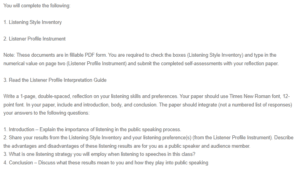Listening Self-Assessment and Reflection
Listening is essential in public speaking because it allows presenters to judge their audience’s reactions and adjust their message accordingly, resulting in effective communication. Effective listening enables presenters to determine whether their message is being understood and conveyed correctly, allowing them to make in-the-moment adjustments to maintain audience interest and comprehension. Listening to audience feedback and questions following a speech also allows speakers to answer problems, clarify topics, and create rapport with their audience, ultimately increasing the overall effect of their presentation.
Based on the Listening Style Inventory, I have a listening style that lies between the “Involved” and “Passive” classifications, with occasional tendencies toward “Active” in particular settings. According to the Listener Profile Instrument, my listening style looks to be a mix of “Action-Oriented” and “Content-Oriented.” As a public speaker, the benefits include being able to adjust my message to audience preferences by understanding their listening styles; however, the drawback may be the difficulty of engaging both action-oriented and content-oriented listeners at the same time, as their preferences differ. As an audience member, the benefit is my ability to understand and enjoy organized and technical content, and the disadvantage is that I may grow impatient with speakers who do not match these criteria, thereby hurting my involvement with their presentations.
When listening to presentations in this class, a listening style I will use is active listening, in which I will endeavor to give my complete attention to the speaker, maintain eye contact, and provide nonverbal feedback to reflect my participation. In addition, I will make an attempt to ask clarifying questions when necessary to guarantee a comprehensive knowledge of the topic. Finally, I will strive to put personal prejudices and views aside in order to comprehend the speaker’s message objectively and without judgment.
In summary, the findings indicate that my listening style is adaptable and varied, which can be useful in public speaking because it allows me to connect with a wide range of audience preferences. Because of my mix of action-oriented and content-oriented listening preferences, I should attempt to balance engaging listeners with organized, task-oriented content while providing complicated and challenging information to appeal to a wider spectrum of audience members. Overall, recognizing my listening skills and inclinations will assist me in tailoring my talks to better resonate with varied listener preferences, hence increasing my effectiveness as a public speaker.
ORDER A PLAGIARISM-FREE PAPER HERE
We’ll write everything from scratch
Question

Listening Self-Assessment and Reflection
You will complete the following:
1. Listening Style Inventory
2. Listener Profile Instrument
Note: These documents are in fillable PDF form. You are required to check the boxes (Listening Style Inventory) type in the numerical value on page two (Listener Profile Instrument) and submit the completed self-assessments with your reflection paper.
3. Read the Listener Profile Interpretation Guide
Write a 1-page, double-spaced, reflection on your listening skills and preferences. Your paper should use Times New Roman font, 12-point font. In your paper, include and introduction, body, and conclusion. The paper should integrate (not a numbered list of responses) your answers to the following questions:
1. Introduction – Explain the importance of listening in the public speaking process.
2. Share your results from the Listening Style Inventory and your listening preference(s) (from the Listener Profile Instrument). Describe the advantages and disadvantages of these listening results are for you as a public speaker and audience member.
3. What is one listening strategy you will employ when listening to speeches in this class?
4. Conclusion – Discuss what these results mean to you and how they play into public speaking

